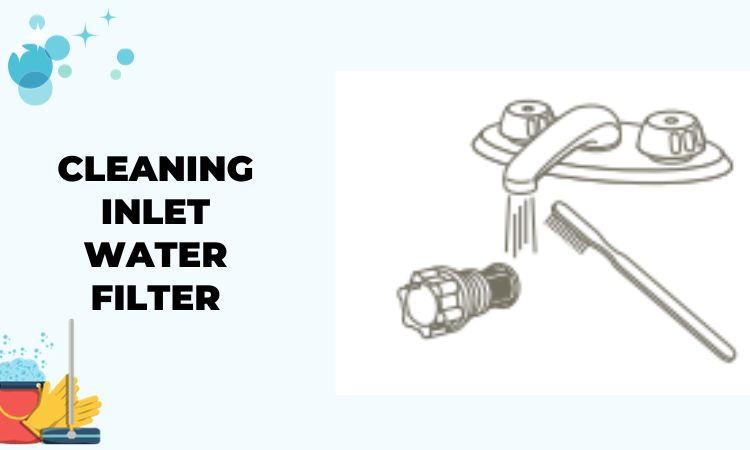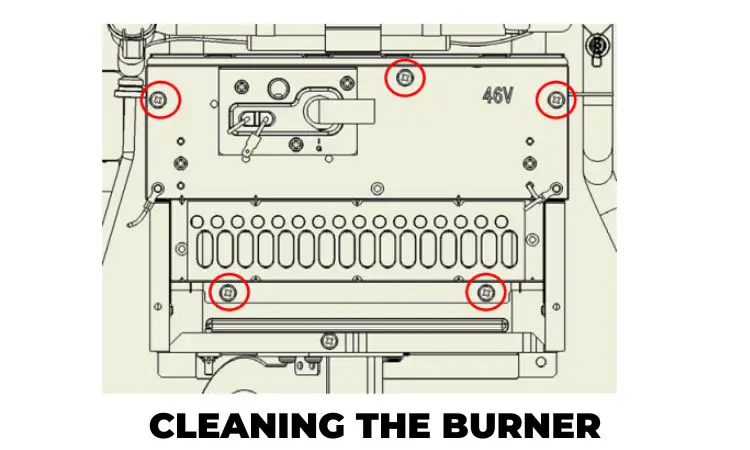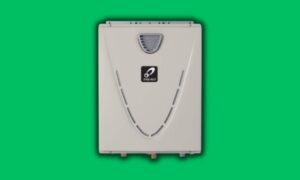What if you’re ready for a nice, warm shower, but when you turn on the tap, there’s no hot water from your Takagi tankless water heater? It’s not a pleasant surprise! But don’t worry, I’ve already dealt with some similar problems and here I am to help you figure out the reason and solution for the Takagi tankless water heater no hot water.
Mostly, due to the below reasons Takagi water heater doesn’t produce hot water.
- Partially opened or closed gas valve
- Incorrect power supply
- Partially opened or closed water valve
- Dirty filter
Now to fix the issues you’ll have to first ensure the right power supply. Next, make sure both the gas and water valves are fully opened. Finally, keep the filter clean.
Well, this is just a summary and there is more to learn. So, keep reading and learn how to fix this no-heating problem of the Takagi water heater.
Table of Contents

Takagi Tankless Water Heater No Hot Water
The problem isn’t simple to deal with. There are some related problems connected to the main heating issue. Aside from no hot water, you can also face not having enough hot water, taking too long to get hot water, or hot water turning cold.
So, I’ve separated 4 different segments considering different conditions. So, check them out below
Condition 1: Takagi Tankless Water Heater No Hot Water When a Fixture is Opened
Here is the first situation. When you open a faucet you may sometimes not get hot water. As per my experience, the problem is common for almost all models of Takagi water heaters. But the reason/solution is sometimes different in terms of different models.
However, I mostly noticed them in the 240HX3, 340HX3, and 540HX3 models. Now, let’s learn about them
There could be several reasons why this Takagi tankless water heater hot heating problem occurs. It can be because of the wrong power supply, partially opened gas/water supply valve, lack of gas, dirty filter, and others.
How To Fix It?
To fix this issue you’ll have to diagnose a few things and work accordingly. Here’s a simple guide to help you figure out and maybe fix the problem.
- Check Power Supply: First, make sure your water heater has the right power supply (120 VAC, 60 Hz). If it doesn’t, it might not work correctly. So, the heater won’t produce hot water.
- Remote or Temperature Controller: If you use a remote or temperature controller, check if the power button is turned on. These controllers help control the water temperature.
- Gas Supply Valve: See if the gas supply valve is fully open. The gas is needed to heat the water, so it must flow properly.
- Water Supply Valve: Similarly, ensure that the water supply valve is fully open. If it’s not, you might not get enough water, and that can lead to less hot water.
- Clean the Filter: Check if the filter on the cold water inlet is clean. A dirty filter can slow down the water and make the heater work less effectively. Here’s how to clean the inlet water filter.

- Close the gas valve if you have one.
- Turn off the power to the water heater and wait a few seconds. Then turn it back on.
- Wait for 30 seconds, and then turn off the power again.
- Close the water valve that brings water into the heater. If your heater is connected to a shared vent system, close both the inlet and outlet water valves to isolate the heater. Then go to the next step.
- Open all the hot water taps in your house. When the water stops flowing, close them all.
- Get a bucket or pan ready to catch the water. Find the big drain plug with a filter on your unit. If you have isolation valves, open them to drain the water. If not, unscrew the big drain plugs to let all the water out. Make sure not to lose the small rubber ring (o-ring) that’s on the large drain plugs.
- Wait a few minutes to be sure all the water is out of the unit.
- Now you’ll have to clean the filter. To do so, first, look for the water filter inside the cold water inlet. Use a small brush to remove any dirt or debris that might be in it. Then put the filter back into the cold water inlet.
- Screw the drain plug back in securely.
- Fixture Flow Rate: Make sure the faucet you’re using for hot water allows at least 0.5 gallons per minute (1.9 liters per minute) of water to flow through it. If not, it can take longer to get hot water.
- Prevent Freezing: If you’re in a really cold area, check if the water heater has frozen. Freezing can damage it and stop it from working.
- Gas Supply (Only Propane Models): If you have a propane water heater, make sure there’s enough gas in the tank or cylinder. If there’s not enough gas, you won’t get hot water.
- Easy Link or Multi-Unit system setup: If you’re a user of 910/910 ASME models you may face the issue for a different reason. Make sure that if you have an Easy Link or Multi-Unit system, it’s set up the right way as per the instructions in the manual or guide. If it’s set up incorrectly, it can cause problems with the water temperature in a multi-unit water heating system.
- Check for Reverse Plumbing: Ensure that the water heater is not plumbed backward with reverse plumbing, as this can lead to issues with hot water delivery when a fixture is opened. (Mostly occurs in the 140 Indoor and 140 Outdoor models)
Condition 2: Takagi Tankless Water Heater Not Enough Hot Water
Here is another situation when you get hot water but the water isn’t hot enough. This mostly happens due to problems in the plumbing system, partially opened/closed gas supply valves, inadequate gas pressure, wrongly adjusted POU mixing valves, and others.
How To Fix It?
If you’re experiencing issues with not getting hot enough water from your Takagi tankless water heater, follow these steps to diagnose and resolve the problem> Below I’m mentioning the ways to do it.
Check Water Flow and Temperature: First of all, you’ll have to ensure proper flow rate and temperature. For different water heater models, the measurement is different. So, you must have to follow the manual and set them to the right measure.
Tips: In the manual follow the section/pont “Output Temperature vs. GPM with Various Inlet Water temperatures” There you’ll find the right measurement.
Inspect Plumbing: Next, you have to inspect your plumbing system for any cross-connections between the cold water lines and hot water lines. These cross-connections can mix cold water with hot water and that results in lower temperatures.
Gas Supply Valve: When the valve isn’t fully open, it limits how much gas can reach the burner. This means the gas flow becomes weaker, and the heater can’t make enough heat. So, the water doesn’t get as hot as it should. So, make sure the gas supply valve is fully opened.
Gas Line Sizing: If the gas line is too small or too big, it can make the heater not produce enough hot water. So, check that the gas line feeding the water heater is appropriately sized. You should get the measurement in the manual.
Keep in mind the sizing is different for Natural gas supply piping and Propane (LP) supply piping.
Gas Supply Pressure: Inadequate gas pressure can affect the heater’s performance. One of the problems that can occur is failing to produce enough hot water. So, confirm that the gas supply pressure meets the required specifications as mentioned in your manual.
Set Temperature: Check the temperature setting on your water heater. If it’s set too low, it may not reach the desired hot water temperature. So, set it accordingly.
POU Mixing Valves: If you have point-of-use (POU) mixing valves installed, ensure they are correctly adjusted. These valves can mix some cold water with hot water to make the water the right temperature at your sinks or showers. Look at the instructions that came with the valves to know how to use them correctly.
Hard Water Scaling: Sometimes, the unit can get scaled up due to hard water. This scale acts like a barrier, making it harder for the heat exchanger to warm the water. In this case, it’s a good idea to get in touch with a service agent who can perform a process called descaling to remove the scale and improve the heater’s performance.
Check for a 101 Error Code: If you see a 101 error code, it means the heater is not getting enough gas, which can lead to a lack of hot water. Investigate if this error code is displayed and follow the instructions in the manual to troubleshoot and resolve the issue.
If you want you can also check my other article on Takagi tankless water heater Error Codes
Inspect Air Flow: Make sure that nothing is blocking the airflow around your heater, as this can affect how hot the water gets. Check for any dust or debris in the vents, inside the burner, or the heat exchanger. If you find any, follow the given steps to clean the burner.
I generally use a safe degreaser to clean it. Let’s check how I do it

- Protect the burner gasket from direct water pressure. If the gasket gets damaged, please contact the technical service department for help.
- Thoroughly saturate the burner with the cleaning solution from the top, down through the slots, and the openings in the front of the burner until it’s completely wet.
- Let the burner sit for 5 minutes.
- Take the burner out of the solution. Place it in an upright position in a sink and wash it with a strong flow of water down into the slots. Start at the back and move forward. Be careful not to touch the gaskets.
- Use compressed air to remove excess water from the burner after rinsing. Check the gasket. (Small surface tears are okay, but significant separations are not acceptable).
NB: The last 3 solutions are mainly for the 520 Indoor/outdoor and 320 indoor/outdoor models
Condition 3: Takagi Tankless Water Heater Takes Too Long to Get Hot Water
This is a less serious condition but here you’ll have to wait a long time to get the desired hot temperature. There can be 2 reasons for facing this issue. First, the longer the distance between your water heater and your faucets or showers, the more time it takes for hot water to travel through the pipes.
Second, when the pipes that carry the hot water are bigger, it can also increase the wait time for hot water to reach your taps.
How To Fix It?
There are 2 solutions to get rid of this issue. Check them below
Recirculation System: Installing a recirculation system is a smart solution to the issue of waiting a long time for hot water. This system ensures that hot water keeps moving through the pipes, reducing the wait time when you turn on your faucets or showers. It’s a convenient way to have hot water ready when you need it without the frustrating delay.
Insulation: Insulating your hot water pipes is a practical approach to cut down on wait times. By wrapping your pipes with insulation material, you help to keep the heat from escaping. This means that the hot water stays warm as it travels through the pipes to your faucets and showers. This helps you wait less for hot water to come out when you turn on the tap. It’s an easy and budget-friendly way to make your hot water system work better
Clean the Filters: Sometimes, filters at the places where water comes into your system can get clogged with dirt and stuff, making the water flow slow. Cleaning these filters regularly can make the water flow better and reduce the time you have to wait for hot water. It’s an easy job that helps your hot water come out faster.
NB: The 3rd solution is more applicable for the 540P Indoor and 540P Outdoor heaters
Condition 4: The Hot Water Turns Cold and Stays Cold
Here’s the final condition where hot water turns cold and remains cold. There are mainly 5 reasons. Below I’ll be mentioning the reasons and solutions. More or less the reasons and solutions are the same for all the models.
- Not Enough Water Flow: Sometimes, if the water doesn’t flow through the heater fast enough, it can’t stay hot. This can make your hot water turn cold.
- Not Enough Check Valves in Recirculation System: If you have a system that moves water around (recirculation), and it doesn’t have enough check valves, cold water can mix with hot water, making it colder.
- Gas Valve Not Fully Open: If the gas valve isn’t wide open, it doesn’t let enough gas get to the heater. This can make it hard to heat the water properly.
- Dirty Cold Water Filter: If the filter where the cold water goes into the heater gets dirty, it can slow down the water. When water flows slowly, the heater can’t keep it hot.
- Blocked Faucets and Showerheads: Sometimes, things like dirt or stuff can block the water in faucets and showerheads. When this happens, hot water can’t come out properly.
How To Fix It?
Here it’s time to get the solutions to this problem.
- Make Sure Water Flows Well: Check that water flows smoothly through your heater. If it doesn’t, you might need to fix your plumbing or find a way to get more water through to keep it hot.
- Use Enough Check Valves: If your system moves water around a lot, make sure there are enough check valves in place. They stop cold water from mixing with the hot, so it stays hot.
- Open the Gas Valve Fully: Be sure the gas valve is fully open. This lets enough gas reach the heater so it can do its job and keep your water hot.
- Clean the Cold Water Filter: Look at the filter where the cold water comes in. If it’s dirty, clean it out. This will help water flow better and keep the heater working well.
- Check Your Fixtures: Take a look at your faucets and showerheads. If they’re blocked by dirt or stuff, clean or replace them. This way, hot water can come out without any problems.
Now What If the Water Is Too Hot
So far we’ve been discussing the problem of the Takagi tankless water heater no hot water. But if you face this issue then there are possibilities you may face the opposite issue. When you pay notice to the Manual of any Takagi tankless water heater, you’ll find this problem along with the explained problem.
Now check out the reasons and solutions to this problem
Set Temperature Too High: If the water is too hot, it’s possible that the set temperature on the water heater is too high. The temperature setting can be adjusted either through the pushbuttons on the PCB (Printed Circuit Board) or by using a remote temperature controller if one is installed.
Obstructed Flow Adjustment Valve: An obstructed flow adjustment valve can lead to lower-than-expected water flow. And because of it, the heater will produce water that is hotter than desired. This obstruction can occur due to hard water scale or debris. To confirm this, it’s necessary to verify water flow using a graduated container or the remote temperature controller, if available.
How To Fix It?
Adjust Set Temperature: If the set temperature is too high, use the push buttons on the PCB or the remote temperature controller (if available) to lower it to a comfortable and safe level.
Inspect and Clean Flow Adjustment Valve: If the water flow is obstructed, inspect the flow adjustment valve for hard water scale or debris. Clean or remove any obstructions to ensure proper water flow and temperature.
FAQs:
How long should it take to get hot water with a tankless water heater?
It typically takes around 15 seconds to heat up the water. However, you’ll still need to wait for that hot water to reach your shower or faucet, similar to how you wait with a traditional tank-type heater.
How much water can a tankless water heater heat?
A tankless water heater can heat a limited amount of water as you use it. Usually, it can handle a flow rate ranging from 2 to 5 gallons per minute. This limitation is important to keep in mind, especially when selecting a tankless hot water heater for a home with multiple faucets and fixtures.
What is the minimum safe temperature for hot water?
The safest minimum temperature for hot water is 60°C when it’s stored, and when it comes out of the taps, it should reach 50°C (or 55°C in healthcare places) within one minute. To evaluate the potential risks of these systems, it’s important to first grasp the system’s type, its parts, and how it works.
Final Verdict
Hopefully, you’ve no more questions on the topic – Takagi tankless water heater no hot water. I’ve tried my best to explain the problem in different situations with proper guidance. So, whatever your situation is, follow the guide I suggested, and hopefully, you’ll be able to fix the Takagi gas water heater no hot water issues.
Now before I end this article let me give you a tip. If you can properly maintain your Takagi water heater, there are fewer chances to face such issues. So, regularly flush the system, clean or replace filters, inspect for leaks, and ensure proper ventilation.
Also, read Takagi tankless water heater not turning on.

